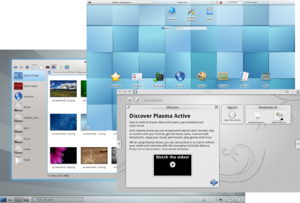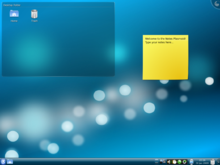KDE Plasma Workspaces
| KDE Plasma Workspaces
|
|
|---|---|
|
|
|
 KDE Plasma Workspaces |
|
| Basic data
|
|
| developer | KDE |
| Current version | 11/4/22 (August 10, 2015) |
| operating system | FreeBSD , Linux , Solaris , Windows |
| programming language | C ++ ( Qt ) |
| category | Program collection |
| License | GPL and LGPL |
| German speaking | Yes |
| kde.org/workspaces/ | |
The KDE Plasma Workspaces are a set of desktop environments from KDE. They are the successor to the K Desktop Environment and represent an independent product within the KDE Software Compilation 4 program collection . The successor to these desktop environments, also known for short as “KDE Plasma 4” in July 2014, has been KDE Plasma 5 , which is no longer different "Workspaces" (PC, netbook, tablet etc.) exist individually, but a uniform graphical surface exists that automatically adjusts to different devices.
history
In K Desktop Environment 1 , the desktop background was displayed by the file manager , similar to Windows . From version 2 the functions have been outsourced to separate programs: While file management functions have been provided by Konqueror since then , the desktop and taskbar were managed by KDesktop and Kicker .
From 2005 in particular, widget engines that display mini-programs on the desktop surface became increasingly popular. The KDE project with SuperKaramba also had a widget engine. At the same time, Kicker made it possible to integrate mini-programs into the taskbar, but they were technically incompatible with the SuperKaramba widgets. During the development of KDE 4.0, some KDE developers, under the leadership of Kicker chief developer Aaron J. Seigo , decided to combine the desktop components KDesktop, Kicker and SuperKaramba in one application.
The last version 4.11.22 of the KDE Plasma Workspaces was published on August 19, 2015.
surfaces
In contrast to previous generations, the flexible design of the technical foundation, especially plasma , allows adaptation to a wide variety of device types and form factors . The KDE project calls the resulting different interfaces workspaces .
Desktop
Plasma Desktop is the surface that was completed first and supplied as a technology preview with KDE 4.0. It is aimed at desktop PCs and notebooks that are primarily operated with a mouse (computer) or similar pointing devices . The standard layout of the control elements is roughly based on the earlier K Desktop Environments and Windows : A task bar with a clock and a notification field at the bottom of the screen, icons can be stored on the screen background using the "folder view" element.
Apart from the standard arrangement, the controls can be placed almost completely freely.
Netbook
Plasma Netbook is the second surface that has been completed and is aimed at netbooks . It has been officially delivered since version 4.4, which appeared in February 2010, even though Kubuntu published an unfinished technology preview based on SC 4.3 in October 2009.
The netbook interface essentially consists of two views:
- A view called " newspaper " in which plasma widgets are arranged in columns based on newspaper layouts.
- The "Find and Run" view, used to find and open applications and files.
Since netbooks have very small screens, applications are always run in full screen. In addition, the window frames and controls are hidden by default to save screen space.
Active
Plasma Active , an interface for tablet PCs and tablet computers , was released on October 9, 2011. The adaptation of this surface to smartphones is carried out under the name Plasma Mobile . The developers are planning a usable version for the KDE developer conference Akademy 2016.
Applications must also be adapted to the touchscreens of these devices. The first step in this direction was a document viewer for the N900 developed on the basis of Calligra Suite / KOffice on behalf of Nokia .
The next steps are the porting of the Kontact applications. As part of this porting work, a user interface library based on the Qt Markup Language (QML) is being developed that can be used by other KDE applications.
Very first technology preview from Plasma Mobile on the " Tokamak 4 ".
Plasma Mobile technology preview as video.
KOffice document viewer under Maemo 5 .
Components
The core component of the Plasma Workspaces is the surface framework called Plasma , which, however, is not in itself a desktop environment. Further core components are the composition and window manager KWin and the KDE Display Manager (KDM), which was no longer maintained with Plasma 5 and was preferably replaced by SDDM . In addition, some other components such as B. Daemons included.
technical basics
Plasma was designed with the goal of not being a further implementation of a desktop surface, but a general framework for creating user interfaces. From this point of view, the actual desktop surface is only an example implementation. In fact, plasma is also used in programs that are not related to the desktop, especially for the context view of the KDE media player Amarok (from version 2.0).
The surface in Plasma consists of widgets ( English for mini-programs ) that graphically represent self-contained use cases. (The term applet , in some cases also plasmoid , is used synonymously .) On a desktop, for example, a clock is a widget that is used to display the current time.
The arrangement of the widgets on the surface is by special parent boxes , so-called containment (engl. For container ) determines the certain widgets geometric specifications ( shape factor ) can impose. While widgets float freely on the desktop background, for example, and can be of (almost) any size, their height in the taskbar is severely limited. Almost all widgets in Plasma adapt their shape according to the outer form factor: For example, while the start menu widget on the desktop always shows the complete start menu, it becomes a button in the taskbar that shows the start menu when clicked.
A central point in plasma is the separation of data and presentation: While a widget only cares about the presentation of data in the ideal case, the procurement and processing of data from a Data Engine (English for. Data Machine assumed). A similar structure enables widgets to actively interact with web-based services.
criticism
Although work on Plasma began in June 2005, the software for the release of KDE 4.0 in January 2008 was not as mature as hoped. Over the course of the year, many users complained about frequent plasma crashes, slowdowns in speed, especially in connection with Nvidia graphics cards, and the lack of many functions known from KDesktop and Kicker from the KDE 3 era.
A particularly intense controversy flared up over file icons on the desktop: The traditional task of the desktop is to display files that are stored in a special desktop folder on the hard drive using freely placeable desktop icons. This functionality was only available to a very limited extent in KDE 4.0. For KDE 4.1, the temporary solution was completely removed and replaced by folder view , which, however, was only fully implemented with KDE 4.2.
With version 4.2, the desktop interface was considered fully developed. Test reports were mostly positive from this point on. While 4.0 did not replace K Desktop Environment 3.5 in any better-known Linux distribution except Fedora , 4.2 was considered mature enough to be included in the stabilization branch of the more conservative Debian distribution , instead of continuing to K Desktop Environment 3.5 or its continuation Trinity Desktop Environment to put.
Individual evidence
- ↑ KDE Ships KDE Applications 08.15.0. August 10, 2015, accessed April 22, 2019 .
- ↑ Licensing information for KDE packages ( Memento from February 9, 2010 in the Internet Archive )
- ↑ https://www.kde.org/announcements/plasma5.0/ KDE announcement from July 15, 2014 for Plasma 5 with repeated mention of the "Plasma 4.x series"
- ↑ Public announcement of the project in the blog of Aaron J. Seigo, (English)
- ↑ https://kde.org/announcements/announce-applications-15.08.0.php
- ↑ http://kde.org/announcements/plasma-active-one/
- ↑ Plasma Mobile brings KDE 5 to the smartphone from heise.de, accessed on October 7, 2015
- ↑ Archive link ( Memento of the original dated November 24, 2010 in the Internet Archive ) Info: The archive link was inserted automatically and has not yet been checked. Please check the original and archive link according to the instructions and then remove this notice.
- ↑ http://steveire.wordpress.com/2010/04/30/kdepim-on-mobile-whats-going-on/
- ↑ [Kde-maemo] QML UI for KDE
- ↑ Display Managers In Plasma 5 ( Memento of the original from August 27, 2015 in the Internet Archive ) Info: The archive link was inserted automatically and has not yet been checked. Please check the original and archive link according to the instructions and then remove this notice. In: David Edmundson's Web Log, accessed September 3, 2015
- ↑ Plasma on Netbooks (explanation of the meaning of an "interface framework", English)
- ↑ Aaron Seigo: educating expectations (English)
- ↑ Archive link ( Memento of the original from August 22, 2009 in the Internet Archive ) Info: The archive link was inserted automatically and has not yet been checked. Please check the original and archive link according to the instructions and then remove this notice. (Link no longer available)
- ↑ Alexander Dymo: KDE 4.2 Review From Inside Out. Part 1. alexdymo.com, January 10, 2009, accessed April 15, 2015 .
- ↑ http://lists.debian.org/debian-kde/2009/03/msg00157.html





